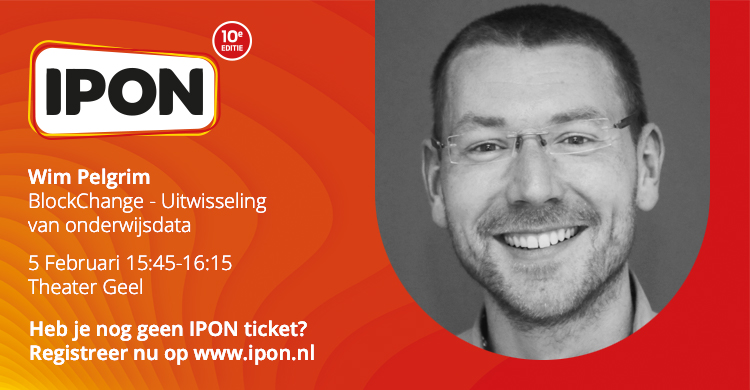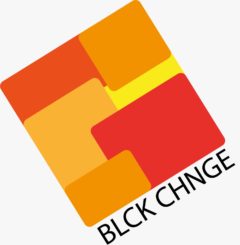https://www.omo.nl/actueel/DU3502_BlockChangeEU.aspx?utm_medium=email
Categorie archieven: Linkdump
BlockChange @ IPON

BlockChange is present at the IPON convention in Jaarbeurs Utrecht on February 5th 2020:
Blockchain helps us to shape the future of education
I work on blockchain and I work on education. I wrote about education as a DAO before. But because that was a thought experiment, today I want to tell you about what I think the near future will look like. Or at least I hope this will be the near future.
First, diplomas are becoming less important. Big tech companies hire people for the people they are and teach them afterward. And universities are also thinking about their role in the next ten to fifteen years. Like Avans University of Applied Sciences in the Southern part of The Netherlands. Avans was chosen as the best large university of applied sciences in The Netherlands for five years in a row and the local newspaper had an interview with chairman of the board Paul Rüpp.
Rüpp tells in the interview that the school is going to make their courses and studies more flexible. He paints us a picture of a future in which students also work and only follow the courses that the employer requires. And Rüpp isn’t the only chairman talked about the sustainability of diplomas in The Netherlands. Paul Rosenmöller, head of the Council for Secondary Education (VO-raad) made the same kind of statements in March of this year.
And if that is the future (and I strongly believe it will or should), this will change the way we would like to display students results. Because results aren’t just simple grades, certificates or diplomas anymore. For my project BlockChange.EU I use the following images to show how I think we need to change the way we look at students.


But a student isn’t Ronaldo, so we need a more detailed look at who a student is. Michelle Weise wrote an article for the Harvard Business Review about visualizing people’s skills. Using the data from 25 million job postings, Weise company created a grid to show the skills that employers demand from their applicants. This grid could be another way of showing your skills.

But how would you be able to show this kind of data? You would have to have a lot of datapoints. And the ideal way to store a lot of datpoints from different contributors (schools, educational applications, external certifying agencies, internships) in a network around a student is blockchain. Every learning moment with every teacher, using every app would be stored on blockchain and that data would be the result ánd next step in a student’s development. The learning moment, the learning experience a student has, guided by a teacher, is the start and finish of this vision.

But if you make blockchain the foundation for this vision of the future, what could that do for education, besides being a different way of storing data in a network? Ermos Kyriakides wrote a piece on that on Hackernoon.
And he describes three powerful changes for education. Following his layout, I’ll show you how the grid and blockchain and the future of education are a match made in heaven.
1.Proof of Ownership
Who owns student data? The student? The school? The organization contracted by the school or district? The government? In my vision it is the student: it is your development, your learning path, your life. And you are the owner of your data. In blockchain you are. And you decide who can see, add and use information you provide. And who is cut off from your data.
But that’s not the only thing: you can easily prove you are the original content creator, you can build a transparent (and proven) work portfolio, teaching autonomy and self-assuredness.
2. Decentralized Information Sharing
But the blockchain is also decentralized and that makes global information sharing a lot easier for both students and for information. Fleeing from a conflict area? Emigrating? Your credentials travel with you, without a lot of bureaucratic trouble or the feeling you are entering a Kafka novel. You can take off from where you left.
3. Tokenized Economy
The last topic Kyriakides talks about is tokenization. And yes, Open Badges are a thing in education. And if you don’t know them, check out https://openbadges.org. But the tokenization in the Hackernoon-article is a way blockchain and education could be part of online/distant learning. But I believe in the power of student-teacher interaction. And that demands student-teacher contact. But maybe I’m missing something in my view.
In short: in my vision for the future, education is a series of learning experiences of which the results will be stored on blockchain for later use by the owner of that data, the student. And that data can be visualized in several ways to help students show what they can and help them take the next step in their development. Let’s embrace that future and take that first step with me. And tell me how you think we should develop education.
Onderwijsresultaten samenbrengen met BlockChange – Blocker
 Voor de website Blocker.nl mocht ik een gastbijdrage schrijven over BlockChange. Je leest het artikel hier: Onderwijsresultaten samenbrengen met BlockChange – Blocker
Voor de website Blocker.nl mocht ik een gastbijdrage schrijven over BlockChange. Je leest het artikel hier: Onderwijsresultaten samenbrengen met BlockChange – Blocker
A nice explination of the blockchain by IBM
Nice longread from the NYT
The New York Times published a nice article about the future of the blockchain after the bitcoin bubble: https://www.nytimes.com/2018/01/16/magazine/beyond-the-bitcoin-bubble.html
Two great blockchain ideas
Last week two great blockchain initiatives were presented: the first is KODAK and WENN Digital Partners idea for a blockchain on copyright of pictures. Second is the New York based idea to give homeless people an identity (link in Dutch) and way of managing their money.
Twee rapporten over de blockchain in het onderwijs
Afgelopen week verschenen twee superinteressante onderzoeksrapporten over de toepassing van de blockchain in het onderwijs. SURFnet (ict- en netwerkorganisatie in het hoger onderwijs) en de Europese Unie hebben zich de vraag gesteld wat de blockchain kan betekenen in het onderwijs. Allereerst het mij meest tegenvallende rapport, dat van SURF.
Eén van de conclusies is helder, de blockchain is nog niet volwassen en ook niet dé oplossing. De auteurs schrijven echter:
Of anders gesteld, blockchain kan meer gezien worden als een mogelijk onderdeel van een oplossing, dan als ‘de’ oplossing.
Daar kan ik mij volledig in vinden. Waar ze de plank misslaan is de wijze waarop ze naar de techniek in relatie tot het onderwijs kijken. Er wordt erg uitgegaan van de status quo en daarvoor zijn inderdaad bestaande oplossingen voldoende of zelfs goed. Maar de transformerende eigenschappen van de blockchain, het anders naar de verhoudingen kijken in het onderwijsveld en de wijze waarop we met onderwijsresultaten omgaan wordt slechts zijdelings genoemd.
Om een vergelijking op te zetten die voortbouwt op de bekende (niet van Henry Ford afkomstige) quote; het is alsof je een paardenverzorger (SURF) begin 20e eeuw vraagt naar de impact van de auto. Het antwoord van SURF zou in die tijd zijn geweest dat het misschien handig kan zijn om voer naar zijn paard te rijden, maar dat zijn dagelijks werk er waarschijnlijk niet anders door zal worden…
Wat dit rapport in mijn ogen mist is het zicht op de horizon, het zicht is vooral gericht op de volgende drie stappen en die zullen niet groot zijn. Maar zonder ‘big picture’ ook geen ‘first step’. Grote transformaties hoeven we vanuit SURF helaas niet direct te verwachten, maar ook niet op de langere termijn, zo lijkt het.
En de EU?
De EU heeft een uitgebreidere studie gedaan. Op BCINED2017 presenteerde Andreia Inamorato dos Santos de concept-conclusies al en het rapport ziet er degelijk en weloverwogen uit. Processen op de blockchain (de techniek) en processen in het onderwijs, zoals certificering worden uit en te na beschreven en gekeken wordt waar links te leggen zijn. De kansen voor certificering via de blockchain zijn groot, maar er wordt uiteraard ook opgemerkt dat de techniek nog in de kinderschoenen staat. Of de ECTS als standaard nu zo logisch zijn, waag ik te betwijfelen, maar het is het enige dat op Europees niveau gestandaardiseerd is, dus dat kan dan ook als enige bestaande systeem gehanteerd worden door de onderzoekers.
Ook de scenario’s gaan een stuk breder dan SURF, waarbij met name scenario 4 mijn aandacht trekt:
Using a blockchain as a lifelong learning passport
Toewerken naar een verifieerbaar CV, dat je leerweg gedurende je leven vastlegt en onderwijs en arbeidsmarkt verbindt. Dat is waar ik van droom en waar we met stapjes naar toe kunnen werken.
Interessant leesvoer voor eenieder die wil nadenken over de infrastructuur die nodig is voor de toekomst van het onderwijs. Want als het onderwijs verandert, moeten we ook nadenken over de manier waarop we onszelf de ruimte geven en de tools in handen geven om dat onderwijs goed te kunnen geven.
The European Union report on blockchain in education
The European Union has published a report on the blockchain in education. It’s a scientific an technical research report, that can be found here: https://ec.europa.eu/jrc/en/publication/eur-scientific-and-technical-research-reports/blockchain-education.
Great article about the power of blockchain in education
Blockchain is a technology that clearly has applications in the world of learning at the individual, institutional, group, national and international levels. It is relevant in all sorts of contexts: schools, colleges, universities, MOOCs, CPD, corporates, apprenticeships, and knowledge bases.
Rather than the old hierarchical structures, the technology becomes the focus, with trust migrating towards the technology, not the institutions. It is really is a disintermediation technology.
Click the link and read more about it!
https://oeb-insights.com/10-ways-blockchain-could-be-used-in-education/




